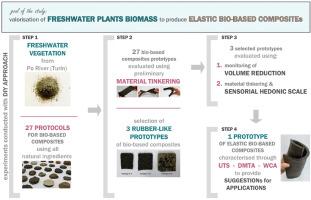VALORISATION OF FRESHWATER WEEDS BIOMASS TO PRODUCE BIO-BASED COMPOSITES THROUGH DO-IT-YOURSELF APPROACH
IF 10
1区 环境科学与生态学
Q1 ENGINEERING, ENVIRONMENTAL
引用次数: 0
Abstract
Bio-based composites have gained increasing attention in recent years due to the rising of ecological and sustainability consciousness in disciplines of material science and design practice. Opportunities offered by organic waste and by-products as reinforcing fillers for polymer blends are investigated to improve properties of bio-based material with the aim to replace fossil-based plastics. This study focused on the reuse of freshwater weeds biomass as filler for bio-based composite materials obtained using only natural and biodegradable components for matrices. The freshwater weeds biomass involved in this study was mainly composed by the invasive plant species Elodea nuttallii collected during environmental management practices of Po River in the city of Turin (Italy). The study was performed in the framework of Material-Driven Design using the do-it-yourself (DIY) approach to explore opportunities offered by 27 different protocols defined to create bio-based composites. Material Tinkering was adopted as practice to evaluate strengths and weaknesses of prototypes obtained from abovementioned 27 bio-composites in order to select those that presented elastic behaviour of rubber materials. At the end, a single prototype was selected as the most promising that showed rubber-like characteristics. This prototype was characterised through tensile testing and dynamic mechanical thermal analysis (DMTA) to determine their physical and thermal characteristics. The study discusses opportunities and criticalities presented by all 27 bio-composites obtained through DIY approach and evaluated through Material Tinkering, and it suggests potential design applications for the selected rubber-like bio- composite based on its mechanical and thermal properties.


淡水杂草生物量的增值,通过自己动手的方法生产生物基复合材料
近年来,由于材料科学和设计实践中生态和可持续性意识的增强,生物基复合材料越来越受到人们的关注。研究了有机废物和副产品作为聚合物共混物增强填料的机会,以改善生物基材料的性能,以取代化石基塑料。本研究的重点是淡水杂草生物质的再利用,作为生物基复合材料的填料,而生物基复合材料仅使用天然和可生物降解的成分作为基质。本研究涉及的淡水杂草生物量主要由意大利都灵市波河(Po River)环境管理实践中采集的入侵植物Elodea nuttallii组成。该研究是在材料驱动设计的框架下进行的,使用自己动手(DIY)的方法来探索27种不同的方案提供的机会,以创建生物基复合材料。采用材料修补法对上述27种生物复合材料样品的优缺点进行评估,以选择具有橡胶材料弹性性能的样品。最后,选择了一个最具潜力的原型,显示出类似橡胶的特性。该原型通过拉伸测试和动态机械热分析(DMTA)来确定其物理和热特性。该研究讨论了所有27种通过DIY方法获得的生物复合材料所带来的机遇和关键,并通过材料修补进行了评估,并根据其机械和热性能提出了所选择的类橡胶生物复合材料的潜在设计应用。
本文章由计算机程序翻译,如有差异,请以英文原文为准。
求助全文
约1分钟内获得全文
求助全文
来源期刊

Journal of Cleaner Production
环境科学-工程:环境
CiteScore
20.40
自引率
9.00%
发文量
4720
审稿时长
111 days
期刊介绍:
The Journal of Cleaner Production is an international, transdisciplinary journal that addresses and discusses theoretical and practical Cleaner Production, Environmental, and Sustainability issues. It aims to help societies become more sustainable by focusing on the concept of 'Cleaner Production', which aims at preventing waste production and increasing efficiencies in energy, water, resources, and human capital use. The journal serves as a platform for corporations, governments, education institutions, regions, and societies to engage in discussions and research related to Cleaner Production, environmental, and sustainability practices.
 求助内容:
求助内容: 应助结果提醒方式:
应助结果提醒方式:


